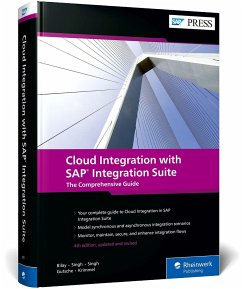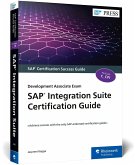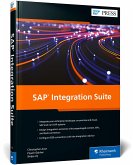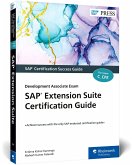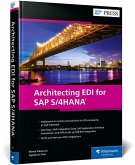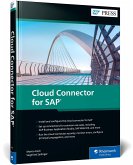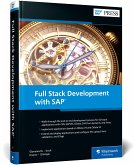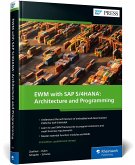John Mutumba Bilay, Shashank Singh, Swati Singh
Cloud Integration with SAP Integration Suite
The Comprehensive Guide
John Mutumba Bilay, Shashank Singh, Swati Singh
Cloud Integration with SAP Integration Suite
The Comprehensive Guide
- Gebundenes Buch
- Merkliste
- Auf die Merkliste
- Bewerten Bewerten
- Teilen
- Produkt teilen
- Produkterinnerung
- Produkterinnerung
Bring your cloud and on-premise applications together with Cloud Integration (formerly SAP Cloud Platform Integration) in SAP Integration Suite! Integrate processes and data in your system, step by step, by developing and configuring integration flows in the SAP BTP, Cloud Foundry environment. Enhance your integrations with APIs, open connectors, and custom adapters. Explore prepackaged content in the content catalog, debug and secure integration projects, connect to third-party systems, and more!
Highlights include: 1) Integration flows 2) Integration content catalog 3) SAP API Business…mehr
Andere Kunden interessierten sich auch für
![SAP Integration Suite Certification Guide SAP Integration Suite Certification Guide]() Jaspreet BaggaSAP Integration Suite Certification Guide64,99 €
Jaspreet BaggaSAP Integration Suite Certification Guide64,99 €![SAP Integration Suite SAP Integration Suite]() Christopher AronSAP Integration Suite63,99 €
Christopher AronSAP Integration Suite63,99 €![SAP Extension Suite Certification Guide SAP Extension Suite Certification Guide]() Krishna Kishor KammajeSAP Extension Suite Certification Guide63,99 €
Krishna Kishor KammajeSAP Extension Suite Certification Guide63,99 €![Architecting EDI for SAP S/4HANA Architecting EDI for SAP S/4HANA]() Marek PiasecznyArchitecting EDI for SAP S/4HANA72,99 €
Marek PiasecznyArchitecting EDI for SAP S/4HANA72,99 €![Cloud Connector for SAP Cloud Connector for SAP]() Martin KochCloud Connector for SAP72,99 €
Martin KochCloud Connector for SAP72,99 €![Full Stack Development with SAP Full Stack Development with SAP]() Rene GlavanovitsFull Stack Development with SAP71,99 €
Rene GlavanovitsFull Stack Development with SAP71,99 €![EWM with SAP S/4HANA: Architecture and Programming EWM with SAP S/4HANA: Architecture and Programming]() Peter ZoellnerEWM with SAP S/4HANA: Architecture and Programming72,99 €
Peter ZoellnerEWM with SAP S/4HANA: Architecture and Programming72,99 €-
-
-
Bring your cloud and on-premise applications together with Cloud Integration (formerly SAP Cloud Platform Integration) in SAP Integration Suite! Integrate processes and data in your system, step by step, by developing and configuring integration flows in the SAP BTP, Cloud Foundry environment. Enhance your integrations with APIs, open connectors, and custom adapters. Explore prepackaged content in the content catalog, debug and secure integration projects, connect to third-party systems, and more!
Highlights include:
1) Integration flows
2) Integration content catalog
3) SAP API Business Hub
4) Modeling synchronous and asynchronous scenarios
5) Debugging
6) Security
7) Operations
8) Root cause analysis
9) Web UI
10) Message mappings
11) SAP API Management
Highlights include:
1) Integration flows
2) Integration content catalog
3) SAP API Business Hub
4) Modeling synchronous and asynchronous scenarios
5) Debugging
6) Security
7) Operations
8) Root cause analysis
9) Web UI
10) Message mappings
11) SAP API Management
Produktdetails
- Produktdetails
- SAP PRESS Englisch
- Verlag: Rheinwerk Verlag / SAP PRESS
- Artikelnr. des Verlages: 459/22471
- 4. Aufl.
- Seitenzahl: 900
- Erscheinungstermin: 1. November 2024
- Englisch
- Abmessung: 262mm x 189mm x 47mm
- Gewicht: 1742g
- ISBN-13: 9781493224715
- ISBN-10: 1493224719
- Artikelnr.: 70175426
- Herstellerkennzeichnung
- Rheinwerk Verlag GmbH
- Rheinwerkallee 4
- 53227 Bonn
- Info@rheinwerk-verlag.de
- +49228421500
- SAP PRESS Englisch
- Verlag: Rheinwerk Verlag / SAP PRESS
- Artikelnr. des Verlages: 459/22471
- 4. Aufl.
- Seitenzahl: 900
- Erscheinungstermin: 1. November 2024
- Englisch
- Abmessung: 262mm x 189mm x 47mm
- Gewicht: 1742g
- ISBN-13: 9781493224715
- ISBN-10: 1493224719
- Artikelnr.: 70175426
- Herstellerkennzeichnung
- Rheinwerk Verlag GmbH
- Rheinwerkallee 4
- 53227 Bonn
- Info@rheinwerk-verlag.de
- +49228421500
John Mutumba Bilay is a senior software engineer and enterprise integration consultant at Rojo Consultancy. With more than 12 years of international experience in information technology, including eight specifically devoted to SAP, his speciality is software development, integration, and business process automation.
... Foreword by Andreas Quenstedt ... 19
... Preface ... 21
... Structure of the Book ... 21
... Sample Applications ... 25
... Who This Book Is For ... 26
... Acknowledgments ... 27
... John Mutumba Bilay ... 27
... Shashank Singh ... 28
... Swati Singh ... 28
1 ... Introduction to Cloud Integration ... 31
1.1 ... The Role of Cloud Integration in a Cloud-Based Strategy ... 33
1.2 ... Use Cases ... 36
1.3 ... Capabilities ... 44
1.4 ... Editions ... 53
1.5 ... Summary ... 54
2 ... Getting Started ... 57
2.1 ... Architecture Overview ... 57
2.2 ... Tools and Processes ... 78
2.3 ... Running Your First Integration Scenario ... 86
2.4 ... Summary ... 123
3 ... SAP Integration Content Catalog ... 125
3.1 ... Introduction to SAP Integration Content Catalog ... 125
3.2 ... Terms and Conditions of Using Prepackaged Integration Content ... 128
3.3 ... Consuming Prepackaged Content ... 131
3.4 ... Prepackaged Content Provided by SAP ... 143
3.5 ... Creating Your Own Content Package ... 156
3.6 ... Adapters to Third-Party Applications for SAP Integration Suite ... 159
3.7 ... Summary ... 162
4 ... Basic Integration Scenarios ... 163
4.1 ... Working with Cloud Integration's Data Model ... 163
4.2 ... Using Externalization to Enable Easy Reuse of Integration Flows ... 185
4.3 ... Calling External Systems by Invoking an OData Service ... 192
4.4 ... Working with Mappings ... 214
4.5 ... Defining and Provisioning API-based Integration ... 234
4.6 ... Message Routing ... 250
4.7 ... Summary ... 260
5 ... Advanced Integration Scenarios ... 261
5.1 ... Working with an Aggregator ... 261
5.2 ... Working with Lists ... 271
5.3 ... Asynchronous Message Handling ... 289
5.4 ... Reliable Messaging Using the JMS Adapter ... 311
5.5 ... SAP Process Integration and the XI Adapters ... 336
5.6 ... Using Event-Driven Messaging ... 336
5.7 ... Summary ... 359
6 ... Special Topics in Integration Development ... 361
6.1 ... Timer-Based Message Transfers ... 362
6.2 ... Using Dynamic Configuration via Headers or Properties ... 370
6.3 ... Structuring Large Integration Flows Using Local Processes ... 391
6.4 ... Connecting Integration Flows Using the ProcessDirect Adapter ... 405
6.5 ... Connecting to a Database Using the JDBC Adapter ... 421
6.6 ... Connecting to an AS2 Server Using an AS2 Adapter ... 428
6.7 ... Versioning and Migration of Integration Flows ... 436
6.8 ... Simulation of Integration Flow Processing ... 448
6.9 ... Transporting Integration Packages to Another Tenant ... 455
6.10 ... Using the Adapter Development Kit ... 460
6.11 ... Guidelines for Integration Flow Development ... 478
6.12 ... Working with Script Collections ... 482
6.13 ... Advanced Message Mapping Concepts ... 488
6.14 ... Summary ... 492
7 ... Cloud Integration Operations ... 493
7.1 ... Operations: Overview ... 493
7.2 ... Monitoring Integration Content and Message Processing ... 495
7.3 ... Managing Security ... 521
7.4 ... Managing Temporary Data ... 560
7.5 ... Accessing Logs ... 576
7.6 ... Managing Locks ... 580
7.7 ... Monitoring Message Usage ... 585
7.8 ... Integrating Cloud Integration with Enterprise Monitoring Tools ... 588
7.9 ... Summary ... 597
8 ... Application Programming Interfaces ... 599
8.1 ... Introduction ... 599
8.2 ... Java APIs Provided by Cloud Integration ... 600
8.3 ... Using the Java API in a User-Defined Function ... 602
8.4 ... Using the Script Step ... 606
8.5 ... Open Data Protocol API ... 611
8.6 ... Using Cloud Integration with API Management ... 646
8.7 ... Summary ... 660
9 ... Connecting to External Third-Party Systems ... 661
9.1 ... Introduction ... 661
9.2 ... Open Connectors: Connectors Catalog ... 663
9.3 ... Open Connectors: Understanding Connectors ... 675
9.4 ... Open Connectors: Understanding Common Resources ... 686
9.5 ... Using Cloud Integration with Open Connectors ... 695
9.6 ... Using Cloud Integration to Connect to Third-Party Systems without Open Connectors ... 704
9.7 ... Summary ... 719
10 ... Cloud Integration Security ... 721
10.1 ... Technical System Landscape ... 722
10.2 ... Processes ... 731
10.3 ... User Administration and Authorization ... 735
10.4 ... Data and Data Flow Security ... 754
10.5 ... Keystore Management ... 819
10.6 ... Summary ... 832
11 ... Productive Scenarios Using Cloud Integration ... 835
11.1 ... Integration of SAP Cloud for Customer and SAP ERP ... 835
11.2 ... Integration of SAP Cloud for Customer with SAP S/4HANA Cloud ... 840
11.3 ... Integration of SAP Marketing Cloud and Various Applications ... 840
11.4 ... Integration of SAP SuccessFactors and SAP ERP ... 842
11.5 ... Integration of SAP Applications with SAP Business Network ... 846
11.6 ... Integration with German Tax Authorities Using the ELSTER Adapter ... 848
11.7 ... SAP S/4HANA Integration with Salesforce ... 851
11.8 ... Summary ... 855
12 ... Special Topics in Cloud Integration ... 857
12.1 ... Edge Integration Cell: Overview ... 857
12.2 ... Edge Integration Cell: High-Level Architecture ... 859
12.3 ... Edge Integration Cell: Setup and Installation ... 864
12.4 ... Develop, Deploy, and Monitor Your Integrations in the Edge Integration Cell ... 869
12.5 ... Migration from SAP BTP, Neo Environment to SAP BTP, Cloud Foundry Environment ... 871
12.6 ... Migration from SAP Process Orchestration to Cloud Integration ... 874
12.7 ... Summary ... 879
13 ... Summary and Outlook ... 881
13.1 ... Integration Content Design ... 882
13.2 ... Connectivity ... 883
13.3 ... Edge Integration Cell ... 884
13.4 ... Migration from SAP Process Orchestration to Cloud Integration ... 885
13.5 ... Summary ... 885
... The Authors ... 887
... Index ... 889
... Preface ... 21
... Structure of the Book ... 21
... Sample Applications ... 25
... Who This Book Is For ... 26
... Acknowledgments ... 27
... John Mutumba Bilay ... 27
... Shashank Singh ... 28
... Swati Singh ... 28
1 ... Introduction to Cloud Integration ... 31
1.1 ... The Role of Cloud Integration in a Cloud-Based Strategy ... 33
1.2 ... Use Cases ... 36
1.3 ... Capabilities ... 44
1.4 ... Editions ... 53
1.5 ... Summary ... 54
2 ... Getting Started ... 57
2.1 ... Architecture Overview ... 57
2.2 ... Tools and Processes ... 78
2.3 ... Running Your First Integration Scenario ... 86
2.4 ... Summary ... 123
3 ... SAP Integration Content Catalog ... 125
3.1 ... Introduction to SAP Integration Content Catalog ... 125
3.2 ... Terms and Conditions of Using Prepackaged Integration Content ... 128
3.3 ... Consuming Prepackaged Content ... 131
3.4 ... Prepackaged Content Provided by SAP ... 143
3.5 ... Creating Your Own Content Package ... 156
3.6 ... Adapters to Third-Party Applications for SAP Integration Suite ... 159
3.7 ... Summary ... 162
4 ... Basic Integration Scenarios ... 163
4.1 ... Working with Cloud Integration's Data Model ... 163
4.2 ... Using Externalization to Enable Easy Reuse of Integration Flows ... 185
4.3 ... Calling External Systems by Invoking an OData Service ... 192
4.4 ... Working with Mappings ... 214
4.5 ... Defining and Provisioning API-based Integration ... 234
4.6 ... Message Routing ... 250
4.7 ... Summary ... 260
5 ... Advanced Integration Scenarios ... 261
5.1 ... Working with an Aggregator ... 261
5.2 ... Working with Lists ... 271
5.3 ... Asynchronous Message Handling ... 289
5.4 ... Reliable Messaging Using the JMS Adapter ... 311
5.5 ... SAP Process Integration and the XI Adapters ... 336
5.6 ... Using Event-Driven Messaging ... 336
5.7 ... Summary ... 359
6 ... Special Topics in Integration Development ... 361
6.1 ... Timer-Based Message Transfers ... 362
6.2 ... Using Dynamic Configuration via Headers or Properties ... 370
6.3 ... Structuring Large Integration Flows Using Local Processes ... 391
6.4 ... Connecting Integration Flows Using the ProcessDirect Adapter ... 405
6.5 ... Connecting to a Database Using the JDBC Adapter ... 421
6.6 ... Connecting to an AS2 Server Using an AS2 Adapter ... 428
6.7 ... Versioning and Migration of Integration Flows ... 436
6.8 ... Simulation of Integration Flow Processing ... 448
6.9 ... Transporting Integration Packages to Another Tenant ... 455
6.10 ... Using the Adapter Development Kit ... 460
6.11 ... Guidelines for Integration Flow Development ... 478
6.12 ... Working with Script Collections ... 482
6.13 ... Advanced Message Mapping Concepts ... 488
6.14 ... Summary ... 492
7 ... Cloud Integration Operations ... 493
7.1 ... Operations: Overview ... 493
7.2 ... Monitoring Integration Content and Message Processing ... 495
7.3 ... Managing Security ... 521
7.4 ... Managing Temporary Data ... 560
7.5 ... Accessing Logs ... 576
7.6 ... Managing Locks ... 580
7.7 ... Monitoring Message Usage ... 585
7.8 ... Integrating Cloud Integration with Enterprise Monitoring Tools ... 588
7.9 ... Summary ... 597
8 ... Application Programming Interfaces ... 599
8.1 ... Introduction ... 599
8.2 ... Java APIs Provided by Cloud Integration ... 600
8.3 ... Using the Java API in a User-Defined Function ... 602
8.4 ... Using the Script Step ... 606
8.5 ... Open Data Protocol API ... 611
8.6 ... Using Cloud Integration with API Management ... 646
8.7 ... Summary ... 660
9 ... Connecting to External Third-Party Systems ... 661
9.1 ... Introduction ... 661
9.2 ... Open Connectors: Connectors Catalog ... 663
9.3 ... Open Connectors: Understanding Connectors ... 675
9.4 ... Open Connectors: Understanding Common Resources ... 686
9.5 ... Using Cloud Integration with Open Connectors ... 695
9.6 ... Using Cloud Integration to Connect to Third-Party Systems without Open Connectors ... 704
9.7 ... Summary ... 719
10 ... Cloud Integration Security ... 721
10.1 ... Technical System Landscape ... 722
10.2 ... Processes ... 731
10.3 ... User Administration and Authorization ... 735
10.4 ... Data and Data Flow Security ... 754
10.5 ... Keystore Management ... 819
10.6 ... Summary ... 832
11 ... Productive Scenarios Using Cloud Integration ... 835
11.1 ... Integration of SAP Cloud for Customer and SAP ERP ... 835
11.2 ... Integration of SAP Cloud for Customer with SAP S/4HANA Cloud ... 840
11.3 ... Integration of SAP Marketing Cloud and Various Applications ... 840
11.4 ... Integration of SAP SuccessFactors and SAP ERP ... 842
11.5 ... Integration of SAP Applications with SAP Business Network ... 846
11.6 ... Integration with German Tax Authorities Using the ELSTER Adapter ... 848
11.7 ... SAP S/4HANA Integration with Salesforce ... 851
11.8 ... Summary ... 855
12 ... Special Topics in Cloud Integration ... 857
12.1 ... Edge Integration Cell: Overview ... 857
12.2 ... Edge Integration Cell: High-Level Architecture ... 859
12.3 ... Edge Integration Cell: Setup and Installation ... 864
12.4 ... Develop, Deploy, and Monitor Your Integrations in the Edge Integration Cell ... 869
12.5 ... Migration from SAP BTP, Neo Environment to SAP BTP, Cloud Foundry Environment ... 871
12.6 ... Migration from SAP Process Orchestration to Cloud Integration ... 874
12.7 ... Summary ... 879
13 ... Summary and Outlook ... 881
13.1 ... Integration Content Design ... 882
13.2 ... Connectivity ... 883
13.3 ... Edge Integration Cell ... 884
13.4 ... Migration from SAP Process Orchestration to Cloud Integration ... 885
13.5 ... Summary ... 885
... The Authors ... 887
... Index ... 889
... Foreword by Andreas Quenstedt ... 19
... Preface ... 21
... Structure of the Book ... 21
... Sample Applications ... 25
... Who This Book Is For ... 26
... Acknowledgments ... 27
... John Mutumba Bilay ... 27
... Shashank Singh ... 28
... Swati Singh ... 28
1 ... Introduction to Cloud Integration ... 31
1.1 ... The Role of Cloud Integration in a Cloud-Based Strategy ... 33
1.2 ... Use Cases ... 36
1.3 ... Capabilities ... 44
1.4 ... Editions ... 53
1.5 ... Summary ... 54
2 ... Getting Started ... 57
2.1 ... Architecture Overview ... 57
2.2 ... Tools and Processes ... 78
2.3 ... Running Your First Integration Scenario ... 86
2.4 ... Summary ... 123
3 ... SAP Integration Content Catalog ... 125
3.1 ... Introduction to SAP Integration Content Catalog ... 125
3.2 ... Terms and Conditions of Using Prepackaged Integration Content ... 128
3.3 ... Consuming Prepackaged Content ... 131
3.4 ... Prepackaged Content Provided by SAP ... 143
3.5 ... Creating Your Own Content Package ... 156
3.6 ... Adapters to Third-Party Applications for SAP Integration Suite ... 159
3.7 ... Summary ... 162
4 ... Basic Integration Scenarios ... 163
4.1 ... Working with Cloud Integration's Data Model ... 163
4.2 ... Using Externalization to Enable Easy Reuse of Integration Flows ... 185
4.3 ... Calling External Systems by Invoking an OData Service ... 192
4.4 ... Working with Mappings ... 214
4.5 ... Defining and Provisioning API-based Integration ... 234
4.6 ... Message Routing ... 250
4.7 ... Summary ... 260
5 ... Advanced Integration Scenarios ... 261
5.1 ... Working with an Aggregator ... 261
5.2 ... Working with Lists ... 271
5.3 ... Asynchronous Message Handling ... 289
5.4 ... Reliable Messaging Using the JMS Adapter ... 311
5.5 ... SAP Process Integration and the XI Adapters ... 336
5.6 ... Using Event-Driven Messaging ... 336
5.7 ... Summary ... 359
6 ... Special Topics in Integration Development ... 361
6.1 ... Timer-Based Message Transfers ... 362
6.2 ... Using Dynamic Configuration via Headers or Properties ... 370
6.3 ... Structuring Large Integration Flows Using Local Processes ... 391
6.4 ... Connecting Integration Flows Using the ProcessDirect Adapter ... 405
6.5 ... Connecting to a Database Using the JDBC Adapter ... 421
6.6 ... Connecting to an AS2 Server Using an AS2 Adapter ... 428
6.7 ... Versioning and Migration of Integration Flows ... 436
6.8 ... Simulation of Integration Flow Processing ... 448
6.9 ... Transporting Integration Packages to Another Tenant ... 455
6.10 ... Using the Adapter Development Kit ... 460
6.11 ... Guidelines for Integration Flow Development ... 478
6.12 ... Working with Script Collections ... 482
6.13 ... Advanced Message Mapping Concepts ... 488
6.14 ... Summary ... 492
7 ... Cloud Integration Operations ... 493
7.1 ... Operations: Overview ... 493
7.2 ... Monitoring Integration Content and Message Processing ... 495
7.3 ... Managing Security ... 521
7.4 ... Managing Temporary Data ... 560
7.5 ... Accessing Logs ... 576
7.6 ... Managing Locks ... 580
7.7 ... Monitoring Message Usage ... 585
7.8 ... Integrating Cloud Integration with Enterprise Monitoring Tools ... 588
7.9 ... Summary ... 597
8 ... Application Programming Interfaces ... 599
8.1 ... Introduction ... 599
8.2 ... Java APIs Provided by Cloud Integration ... 600
8.3 ... Using the Java API in a User-Defined Function ... 602
8.4 ... Using the Script Step ... 606
8.5 ... Open Data Protocol API ... 611
8.6 ... Using Cloud Integration with API Management ... 646
8.7 ... Summary ... 660
9 ... Connecting to External Third-Party Systems ... 661
9.1 ... Introduction ... 661
9.2 ... Open Connectors: Connectors Catalog ... 663
9.3 ... Open Connectors: Understanding Connectors ... 675
9.4 ... Open Connectors: Understanding Common Resources ... 686
9.5 ... Using Cloud Integration with Open Connectors ... 695
9.6 ... Using Cloud Integration to Connect to Third-Party Systems without Open Connectors ... 704
9.7 ... Summary ... 719
10 ... Cloud Integration Security ... 721
10.1 ... Technical System Landscape ... 722
10.2 ... Processes ... 731
10.3 ... User Administration and Authorization ... 735
10.4 ... Data and Data Flow Security ... 754
10.5 ... Keystore Management ... 819
10.6 ... Summary ... 832
11 ... Productive Scenarios Using Cloud Integration ... 835
11.1 ... Integration of SAP Cloud for Customer and SAP ERP ... 835
11.2 ... Integration of SAP Cloud for Customer with SAP S/4HANA Cloud ... 840
11.3 ... Integration of SAP Marketing Cloud and Various Applications ... 840
11.4 ... Integration of SAP SuccessFactors and SAP ERP ... 842
11.5 ... Integration of SAP Applications with SAP Business Network ... 846
11.6 ... Integration with German Tax Authorities Using the ELSTER Adapter ... 848
11.7 ... SAP S/4HANA Integration with Salesforce ... 851
11.8 ... Summary ... 855
12 ... Special Topics in Cloud Integration ... 857
12.1 ... Edge Integration Cell: Overview ... 857
12.2 ... Edge Integration Cell: High-Level Architecture ... 859
12.3 ... Edge Integration Cell: Setup and Installation ... 864
12.4 ... Develop, Deploy, and Monitor Your Integrations in the Edge Integration Cell ... 869
12.5 ... Migration from SAP BTP, Neo Environment to SAP BTP, Cloud Foundry Environment ... 871
12.6 ... Migration from SAP Process Orchestration to Cloud Integration ... 874
12.7 ... Summary ... 879
13 ... Summary and Outlook ... 881
13.1 ... Integration Content Design ... 882
13.2 ... Connectivity ... 883
13.3 ... Edge Integration Cell ... 884
13.4 ... Migration from SAP Process Orchestration to Cloud Integration ... 885
13.5 ... Summary ... 885
... The Authors ... 887
... Index ... 889
... Preface ... 21
... Structure of the Book ... 21
... Sample Applications ... 25
... Who This Book Is For ... 26
... Acknowledgments ... 27
... John Mutumba Bilay ... 27
... Shashank Singh ... 28
... Swati Singh ... 28
1 ... Introduction to Cloud Integration ... 31
1.1 ... The Role of Cloud Integration in a Cloud-Based Strategy ... 33
1.2 ... Use Cases ... 36
1.3 ... Capabilities ... 44
1.4 ... Editions ... 53
1.5 ... Summary ... 54
2 ... Getting Started ... 57
2.1 ... Architecture Overview ... 57
2.2 ... Tools and Processes ... 78
2.3 ... Running Your First Integration Scenario ... 86
2.4 ... Summary ... 123
3 ... SAP Integration Content Catalog ... 125
3.1 ... Introduction to SAP Integration Content Catalog ... 125
3.2 ... Terms and Conditions of Using Prepackaged Integration Content ... 128
3.3 ... Consuming Prepackaged Content ... 131
3.4 ... Prepackaged Content Provided by SAP ... 143
3.5 ... Creating Your Own Content Package ... 156
3.6 ... Adapters to Third-Party Applications for SAP Integration Suite ... 159
3.7 ... Summary ... 162
4 ... Basic Integration Scenarios ... 163
4.1 ... Working with Cloud Integration's Data Model ... 163
4.2 ... Using Externalization to Enable Easy Reuse of Integration Flows ... 185
4.3 ... Calling External Systems by Invoking an OData Service ... 192
4.4 ... Working with Mappings ... 214
4.5 ... Defining and Provisioning API-based Integration ... 234
4.6 ... Message Routing ... 250
4.7 ... Summary ... 260
5 ... Advanced Integration Scenarios ... 261
5.1 ... Working with an Aggregator ... 261
5.2 ... Working with Lists ... 271
5.3 ... Asynchronous Message Handling ... 289
5.4 ... Reliable Messaging Using the JMS Adapter ... 311
5.5 ... SAP Process Integration and the XI Adapters ... 336
5.6 ... Using Event-Driven Messaging ... 336
5.7 ... Summary ... 359
6 ... Special Topics in Integration Development ... 361
6.1 ... Timer-Based Message Transfers ... 362
6.2 ... Using Dynamic Configuration via Headers or Properties ... 370
6.3 ... Structuring Large Integration Flows Using Local Processes ... 391
6.4 ... Connecting Integration Flows Using the ProcessDirect Adapter ... 405
6.5 ... Connecting to a Database Using the JDBC Adapter ... 421
6.6 ... Connecting to an AS2 Server Using an AS2 Adapter ... 428
6.7 ... Versioning and Migration of Integration Flows ... 436
6.8 ... Simulation of Integration Flow Processing ... 448
6.9 ... Transporting Integration Packages to Another Tenant ... 455
6.10 ... Using the Adapter Development Kit ... 460
6.11 ... Guidelines for Integration Flow Development ... 478
6.12 ... Working with Script Collections ... 482
6.13 ... Advanced Message Mapping Concepts ... 488
6.14 ... Summary ... 492
7 ... Cloud Integration Operations ... 493
7.1 ... Operations: Overview ... 493
7.2 ... Monitoring Integration Content and Message Processing ... 495
7.3 ... Managing Security ... 521
7.4 ... Managing Temporary Data ... 560
7.5 ... Accessing Logs ... 576
7.6 ... Managing Locks ... 580
7.7 ... Monitoring Message Usage ... 585
7.8 ... Integrating Cloud Integration with Enterprise Monitoring Tools ... 588
7.9 ... Summary ... 597
8 ... Application Programming Interfaces ... 599
8.1 ... Introduction ... 599
8.2 ... Java APIs Provided by Cloud Integration ... 600
8.3 ... Using the Java API in a User-Defined Function ... 602
8.4 ... Using the Script Step ... 606
8.5 ... Open Data Protocol API ... 611
8.6 ... Using Cloud Integration with API Management ... 646
8.7 ... Summary ... 660
9 ... Connecting to External Third-Party Systems ... 661
9.1 ... Introduction ... 661
9.2 ... Open Connectors: Connectors Catalog ... 663
9.3 ... Open Connectors: Understanding Connectors ... 675
9.4 ... Open Connectors: Understanding Common Resources ... 686
9.5 ... Using Cloud Integration with Open Connectors ... 695
9.6 ... Using Cloud Integration to Connect to Third-Party Systems without Open Connectors ... 704
9.7 ... Summary ... 719
10 ... Cloud Integration Security ... 721
10.1 ... Technical System Landscape ... 722
10.2 ... Processes ... 731
10.3 ... User Administration and Authorization ... 735
10.4 ... Data and Data Flow Security ... 754
10.5 ... Keystore Management ... 819
10.6 ... Summary ... 832
11 ... Productive Scenarios Using Cloud Integration ... 835
11.1 ... Integration of SAP Cloud for Customer and SAP ERP ... 835
11.2 ... Integration of SAP Cloud for Customer with SAP S/4HANA Cloud ... 840
11.3 ... Integration of SAP Marketing Cloud and Various Applications ... 840
11.4 ... Integration of SAP SuccessFactors and SAP ERP ... 842
11.5 ... Integration of SAP Applications with SAP Business Network ... 846
11.6 ... Integration with German Tax Authorities Using the ELSTER Adapter ... 848
11.7 ... SAP S/4HANA Integration with Salesforce ... 851
11.8 ... Summary ... 855
12 ... Special Topics in Cloud Integration ... 857
12.1 ... Edge Integration Cell: Overview ... 857
12.2 ... Edge Integration Cell: High-Level Architecture ... 859
12.3 ... Edge Integration Cell: Setup and Installation ... 864
12.4 ... Develop, Deploy, and Monitor Your Integrations in the Edge Integration Cell ... 869
12.5 ... Migration from SAP BTP, Neo Environment to SAP BTP, Cloud Foundry Environment ... 871
12.6 ... Migration from SAP Process Orchestration to Cloud Integration ... 874
12.7 ... Summary ... 879
13 ... Summary and Outlook ... 881
13.1 ... Integration Content Design ... 882
13.2 ... Connectivity ... 883
13.3 ... Edge Integration Cell ... 884
13.4 ... Migration from SAP Process Orchestration to Cloud Integration ... 885
13.5 ... Summary ... 885
... The Authors ... 887
... Index ... 889

